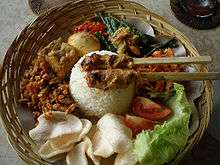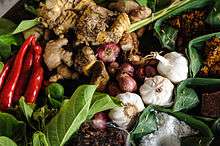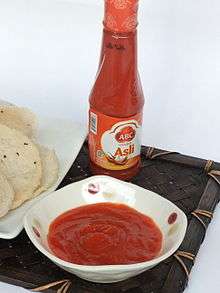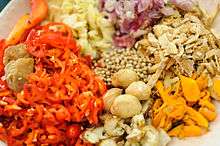Bumbu (seasoning)
Bumbu is the Indonesian word for spices mixture or seasoning, and it commonly appears in the names of certain spice mixtures, sauces and seasoning pastes.[1] It is commonly found in Indonesian cuisine, which includes its regional variants such as Balinese, Javanese, Sundanese, Padang, Batak and Manado cuisines. It is spread over various meats, poultries, seafoods and vegetables; used in stews, soups, barbecue, sotos, gulais, and also as a common addition to Indonesian-style instant noodles. The practice of blending spices, herbs and seasonings is perhaps the most distinctive feature of Indonesian cuisine; it produce some of the most flavorful food in the world.[2]
Indonesians have developed original gastronomic themes with lemongrass and galangal, cardamom and chilies, tamarind and turmeric.[3] The spice mixture are commonly made by slicing, chopping, grounding, beating, bruising or sometimes burning the spices, using traditional cooking tools such as stone pestle and mortar, to modern blender or food processor. The bumbu mixture usually were stir fried in hot cooking oil first to release its aroma, prior to adding main ingredient (meats, poultry, or fishes).
Function

The main function of bumbu is actually the same as common spices; as flavouring agent, to add, enrichen and/or to enhance taste and aroma. However, in tropical Indonesian climate, prior to the discovery of refrigeration technology, the cooking and preparing food through spicing was used to kill the dangerous microbes and to improve food safety. The spices used in Indonesian bumbus such as garlic, shallot, ginger and galangal that are used in rendang have antimicrobial properties and serve as natural organic preservatives.[4] Some of spices are known to inhibit the growth of microbes. That is why if cooked properly, dry rendang can last for as long as four weeks and still safe to be consumed.[5]
Spices


Known throughout the world as the "Spice Islands", the Indonesian islands of Maluku contributed to the introduction of its native spices to world cuisine. Spices such as pala (nutmeg/mace), cengkeh (clove), daun pandan (Pandan leaves), kluwek (Pangium edule) and laos (galangal) are native to Indonesia. It is likely that lada hitam (black pepper), kunyit (turmeric), sereh (lemongrass), salam koja (curry leaf), bawang merah (shallot), kayu manis (cinnamon), kemiri (candlenut), ketumbar (coriander), jahe (ginger) and asam jawa (tamarind) were introduced from India or mainland Southeast Asia, while daun bawang (scallions) and bawang putih (garlic) were introduced from China. Those spices from mainland Asia were introduced early, in ancient times, thus they became integral ingredients in Indonesian cuisine. While the New World spices such as chili pepper and tomato were introduced by Portuguese and Spanish traders during the age of exploration in the 16th century. List of spices used in bumbu are:[6][7][8]
- Adas manis (anise)
- Andaliman (sichuan pepper)
- Asam jawa (tamarind)
- Bawang merah (shallot)
- Bawang putih (garlic)
- Bunga lawang (star anise)
- Cabai rawit (bird's eye chillies)
- Cabai merah (red chili pepper)
- Cengkeh (clove)
- Daun bawang (leek or scallion)
- Daun kari or salam koja (curry leaf)
- Daun pandan (Pandan leaf)
- Daun salam (Indonesian bay leaf)
- Jahe (ginger)
- Jeruk purut (kaffir lime)
- Jeruk nipis (key lime)
- Jintan (caraway)
- Kapulaga (cardamom)
- Kayu manis (cinnamon)
- Kecombrang (wild ginger)
- Kemiri (candlenut)
- Ketumbar (coriander)
- Kluwek or keluwak (Pangium edule)
- Kunyit or kunir (turmeric)
- Lengkuas or laos (galangal)
- Lada hitam (black pepper)
- Pala (nutmeg/mace)
- Sereh (lemongrass)
- Temu kunci (Chinese keys)
- Temu lawak (curcuma)
It is important to note that each bumbu recipes use certain collection or combination of different spices.[2]
Seasonings

Indonesian cuisine also recognize various types of sauces, condiments and seasonings, some are basic seasonings, some are indigenously developed, while another was influenced by Indian, Chinese and European sauces, such as:
- Garam (salt)
- Gula merah or gula jawa (palm sugar)
- Cuka (vinegar)
- Kecap manis (sweet soy sauce)
- Kecap asin (salty or common soy sauce)
- Kecap ikan (fish sauce)
- Kecap inggris (worchestershire sauce)
- Minyak kelapa (coconut oil)
- Minyak samin (ghee)
- Minyak wijen (sesame oil)
- Minyak zaitun (olive oil)
- Saus tomat (tomato ketchup)
- Saus cabai or sambal botol (bottled sambal or hot chili sauce)
- Saus tiram (oyster sauce)
- Santan (coconut milk)
- Kacang tanah (peanuts), fried, grounded, spiced and add water to make peanut sauce. Prepacked ready to use (just add water) satay, pecel or gado-gado peanut sauces are available in Asian grocery store.
- Terasi (shrimp paste)
- Petis (a type of shrimp paste)
- Tauco (fermented soy paste)
- Ang ciu (Chinese cooking red wine)
- Bubuk kaldu (broth powder), similar to bouillon cube but in granular powder.
- Vetsin or mecin (Monosodium glutamate)
Recently there are some additional foreign sauces and seasonings that has been included into Indonesian kitchen and sometimes used as condiment, such as:
- Mayones (mayonnaise)
- Mostar (mustard)
- Saus barbekyu (barbecue sauce)
- Saus teriyaki (teriyaki sauce)
Basic bumbu

In Indonesian cuisine there are myriad variations of bumbu spice mixture, divided according to each recipes and each regional cuisine traditions. For example, Balinese cuisine recognize basa genep bumbu, while Minang cuisine recognize pemasak bumbu. However, there are four generic basic bumbu recognized in Indonesian cuisine divided according to its colours.
- Bumbu dasar putih (basic white bumbu), consists of ground shallot, garlic, galangal, candlenut and corriander, all are stir fried in coconut oil, use it right away or stored in a jar and put in refrigerator for further uses.[9] It can be used in all Indonesian dishes that had whitish color, such as opor ayam, sayur lodeh, various soto, and only need to add Indonesian bay leaf, lemon leaf, and lemongrass. It can also used to cook rawon, semur, mie goreng, various stir fried vegetables, tofu and tempeh dishes.
- Bumbu dasar merah (basic red bumbu), consists of ground red chili pepper, shallot, garlic, tomato, burned shrimp paste, coconut sugar, salt, all are stir fried in coconut oil, use it right away or stored in a jar and put in refrigerator for further uses.[10] It can be used for various Indonesian dishes that have reddish color such as various stir-fried vegetables, nasi goreng, sambal goreng hati, etc., only need to add daun salam (Indonesian bay leaf), bruised lemongrass and galangal.
- Bumbu dasar kuning (basic yellow bumbu), consist of ground shallot, garlic, sauteed candlenut, burned turmeric, coriander, ginger, galangal, black pepper, all are stir fried in coconut oil, use it right away or stored in a jar and put in refrigerator for further uses.[11] It is used in various Indonesian dishes that have yellowish color, such as various soto, pepes, mie goreng and ayam goreng, sometimes acar kuning yellow bumbu are poured upon ikan bakar or ikan goreng.
- Bumbu dasar jingga/oranye (basic orange-colored bumbu), consists of ground red chili pepper, shallot, garlic, caraway, anise, coriander, candlenut, turmeric, ginger, galangal, black pepper, all are stir fried in coconut oil, use it right away or stored in a jar and put in refrigerator for further uses. It is used in various orange-colored Indonesian dishes, such as gulai, Indonesian curry, kalio and rendang.[12]
See also
References
- ↑ Kumar's Curries & Bumbus (2011). "Curries and Bumbus". Verstegen. Retrieved 2011-10-24.
- 1 2 Wina Wiroreno (16 March 2010). "Spice Up Your Life the Indonesian Way". My Cooking Without Borders. Retrieved 8 December 2015.
- ↑ "Indonesia: Spices". Global Gourmet. Retrieved 8 December 2015.
- ↑ Winiati Pudji Rahayu, Aktivitas Antimikroba Bumbu Masakan Tradisional Hasil Olahan Industri Terhadap Bakteri Patogen Perusak
- ↑ Indonesia Proud: William Wongso: Duta Rendang di Dunia Kuliner Internasional
- ↑ "Herbs and Spices, The most important part of Indonesian cooking". Discover Java and Bali. Retrieved 8 December 2015.
- ↑ "Bumbu". Spices of India.
- ↑ "Telor Bumbu Bali".
- ↑ "Bumbu Dasar Putih" (in Indonesian). Sajian Sedap. Retrieved April 1, 2014.
- ↑ "Bumbu Dasar Merah" (in Indonesian). Resep Kita. Retrieved April 1, 2014.
- ↑ "Bumbu Dasar Kuning" (in Indonesian). Sajian Sedap. Retrieved April 1, 2014.
- ↑ "Bumbu Dasar ala Chef Rudi Choirudin - Cocok untuk Ramadhan" (in Indonesian). Resepista. Retrieved April 1, 2014.
External links
| Wikimedia Commons has media related to Spices of Indonesia. |